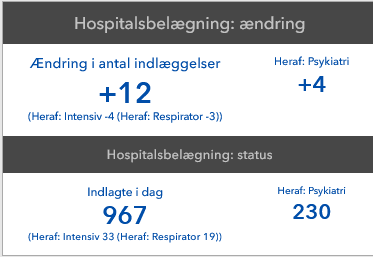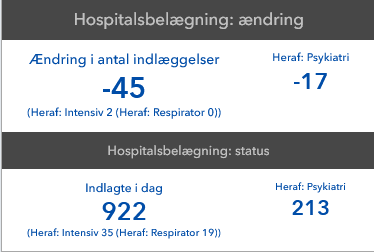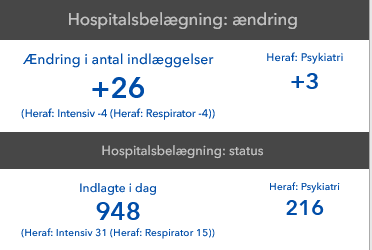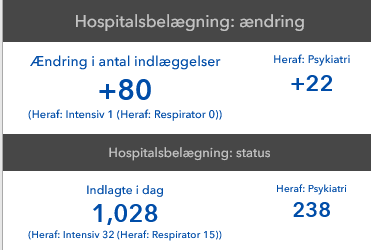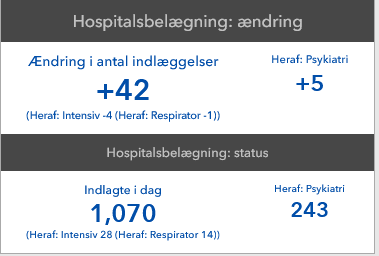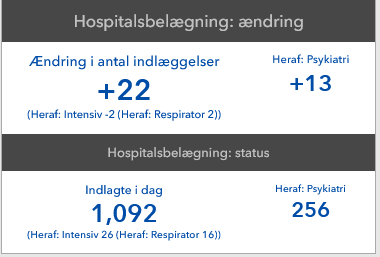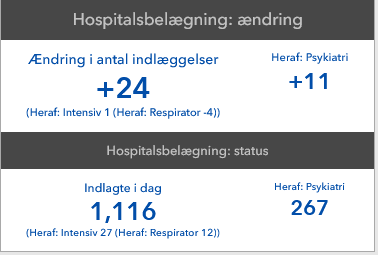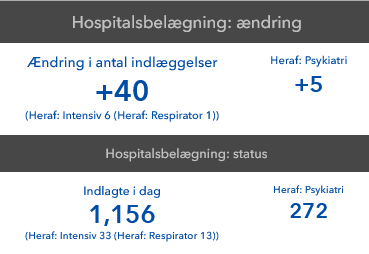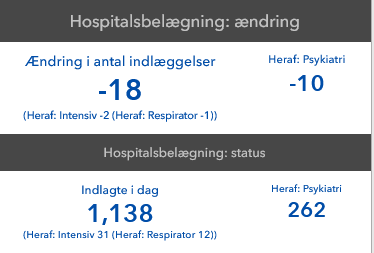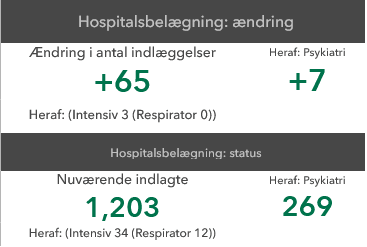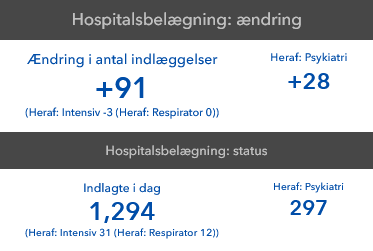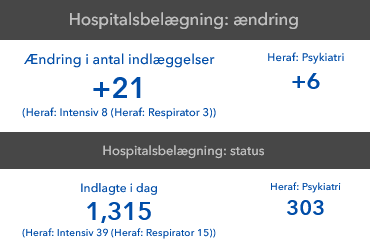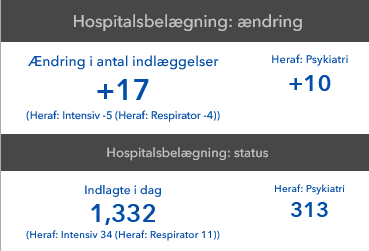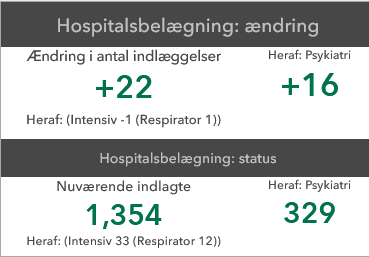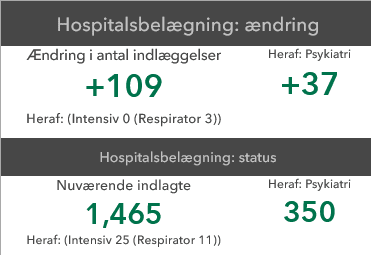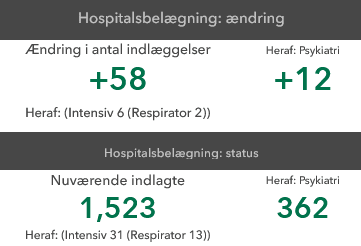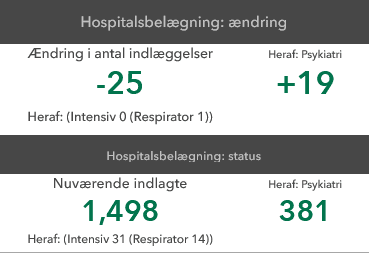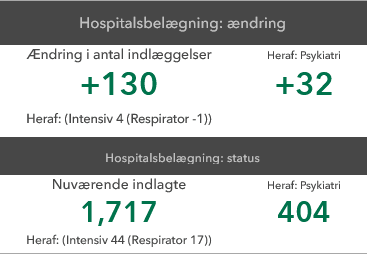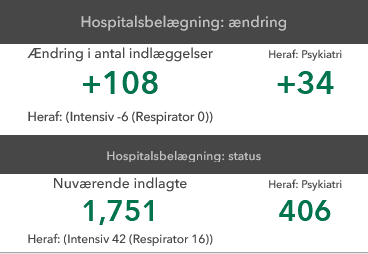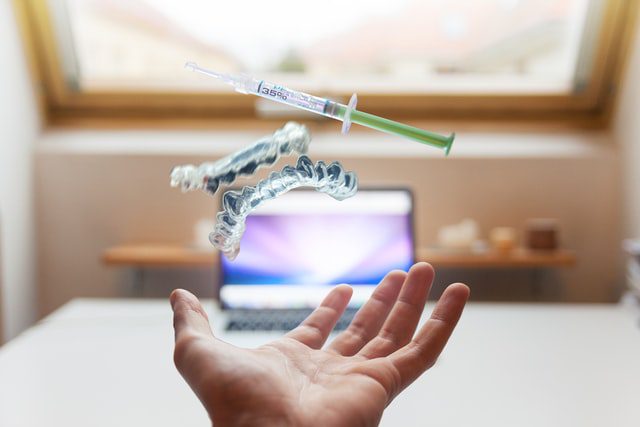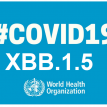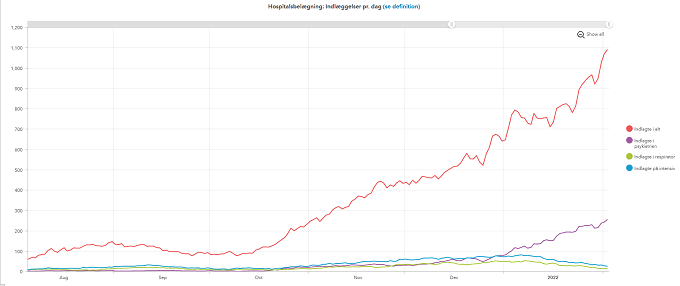
Denmark: Increase in Covid hospitalizations into psychiatric care *17 UPDATES*
There’s been a noticeable change in the nature of Covid hospitalizations in Denmark over the past three weeks. The number of patients going into ICU or onto respirators has dropped quite substantially, but there has been an increase in patients admitted to psychiatric care.
The chart above is from the latest SSI risk assessment for Covid-19, entitled “Risikovurdering for udviklingen i epidemien med covid-19” and can be downloaded from the SSI website here (in Danish).
As you can see from the chart, at the time it was drawn up, more than 200 Covid patients had been admitted to psychiatric care out of a total of some 800 Covid patients in total. On a daily basis, psychiatric admissions are running at about a quarter of all Covid-19 patient admissions to hospital. This appears to be a recent phenomenon, it hasn’t been seen in any previous Sars-CoV-2 wave.
We are not sure why admissions into psychiatry have suddenly started to increase. It may be that these are “incidental” cases – cases where people are testing positive with Covid on admission to psychiatric care for example. It might be a change in reporting methods by Denmark. We haven’t been able to find any explanation for the increase in any Danish report so far. As this change seems to coincide with the arrival of the Omicron variant in Denmark though, we think it’s worth keeping an eye on.
The official Danish Covid-19 dashboard has recently started adding daily figures for hospitalization into ICU and psychiatry, so we will be following those developments and updating the numbers in this post below regularly.
The figures given below for the 27th January 2022. You can see that on that date, there were 12 new patients hospitalized for Covid-19, and four of those were admitted into psychiatric care. There are currently 967 people hospitalized with Covid-19 in Denmark, with 230 of those patients admitted to psychiatric care.
From the Danish Covid-19 dashboard
Translations:
Hospitalsbelægning: ændring = Hospital occupancy: change
Ændring i antal indlæggelser = Change in the number of admissions
Heraf: Psykiatri = Of which Psychiatry
Heraf: Intensiv/Respirator = Of which Intensive/Respirator
Hospitalsbelægning status = Hospital occupancy status
Indlagte i dag = Currently hospitalized
UPDATE 1 – 28th January 2022:
Change in the number of admissions: -45
Of which psychiatry: -17
Currently hospitalized: 922
Of which psychiatry: 213 (23.10%)
UPDATE 2 – 29th January 2022:
Change in the number of admissions: +26
Of which psychiatry: +3
Currently hospitalized: 948
Of which psychiatry: 216 (22.78%)
UPDATE 3 – 30th January 2022:
Change in the number of admissions: +80
Of which psychiatry: +22
Currently hospitalized: 1028
Of which psychiatry: 238 (23.15%)
UPDATE 4 – 31st January 2022:
Change in the number of admissions: +42
Of which psychiatry: +5
Currently hospitalized: 1070
Of which psychiatry: 243 (22.71%)
UPDATE 5 – 1st February 2022:
Change in the number of admissions: +22
Of which psychiatry: +13
Currently hospitalized: 1092
Of which psychiatry: 256 (23.44%)
UPDATE 6 – 2nd February 2022:
Change in the number of admissions: +24
Of which psychiatry: +12
Currently hospitalized: 1116
Of which psychiatry: 267 (23.92%)
UPDATE 7 – 3rd February 2022:
Change in the number of admissions: +40
Of which psychiatry: +5
Currently hospitalized: 1156
Of which psychiatry: 272 (23.53%)
UPDATE 8 – 4th February 2022:
Change in the number of admissions: -18
Of which psychiatry: +10
Currently hospitalized: 1138
Of which psychiatry: 262 (23.02%)
UPDATE 9 – 5th February 2022:
Change in the number of admissions: +65
Of which psychiatry: +7
Currently hospitalized: 1,203
Of which psychiatry: 269 (22.36%)
UPDATE 10 – 6th February 2022:
Change in the number of admissions: +91
Of which psychiatry: +28
Currently hospitalized: 1,294
Of which psychiatry: 297 (22.95%)
UPDATE 11 – 7th February 2022:
Change in the number of admissions: +21
Of which psychiatry: +6
Currently hospitalized: 1,315
Of which psychiatry: 303 (23.04%)
UPDATE 12 – 8th February 2022:
Change in the number of admissions: +17
Of which psychiatry: +10
Currently hospitalized: 1,332
Of which psychiatry: 313 (23.5%)
UPDATE 12 – 8th February 2022:
Change in the number of admissions: +22
Of which psychiatry: +16
Currently hospitalized: 1,354
Of which psychiatry: 329 (24.3%)
UPDATE 13 – 14th February 2022:
Change in the number of admissions: +109
Of which psychiatry: +37
Currently hospitalized: 1,465
Of which psychiatry: 350 (23.89%)
UPDATE 14 – 15th February 2022:
Change in the number of admissions: +58
Of which psychiatry: +12
Currently hospitalized: 1,523
Of which psychiatry: 362 (23.77%)
UPDATE 15 – 16th February 2022:
Change in the number of admissions: -28
Of which psychiatry: +19
Currently hospitalized: 1,498
Of which psychiatry: 381 (25.43%)
UPDATE 16 – 21st February 2022:
Change in the number of admissions: +130
Of which psychiatry: +32
Currently hospitalized: 1,717
Of which psychiatry: 404 (23.53%)
UPDATE 17 – 28th February 2022:
Change in the number of admissions: +108
Of which psychiatry: +34
Currently hospitalized: 1,751
Of which psychiatry: 406 (23.19%)
UPDATE – 15th February 2022:
Denmark’s SSI have had another stab at explaining why there are so many Covid patients going into psychiatric care at the moment. The SSI explanation can be found here (in English)
We are going to republish the entire SSI response below and let you make your own mind up.
Quote>
The psychiatric wards are filling up with COVID-19-patients, e.g. because Denmark has cut ICU beds.
Answer: This is not correct.
Any patient in Denmark in need of intensive care treatment is referred to an ICU. Because of the flexibility of the Danish hospital system, Denmark has at any given time during the pandemic, had enough ICU beds, because other wards were turned into temporary ICUs.
The increasing number of COVID-19 positive persons in psychiatric wards reflects the fact that until week 4 of 2022, an increasing number of persons in Denmark have been infected with the Omicron variant which results in milder disease compared with previous variants.
Also, a very high proportion of the Danish population has been vaccinated against COVID-19 which largely protects against severe disease. For the same reasons, also psychiatric patients – like the rest of the Danish population – experience at present higher rates of COVID-19. But COVID-19 positive psychiatric patients only remain in psychiatric wards if they do not have symptoms of COVID-19 that need to be treated with hospitalisation in somatic hospital wards, let alone ICUs. In conclusion: The psychiatric wards see an increasing number of COVID-19 patients because of the general increase in COVID-19 infected persons in Denmark but none of these patients needs hospitalisation in somatic wards.
<Unquote
UPDATE – 8th February 2022:
There has been some response from Danish commentators on Twitter about the figures Denmark is publishing for Covid patients going into psychiatric care. They are saying that these are incidental cases – people who are admitted to psychiatric care who also have Covid-19 – as we suggested might be the case at the top of this article.
Since Denmark decided to open, misinformation has circulated, incl. conspiracy theories reg. officially manipulated numbers, implying Danish doctors don't treat our patients ("eugenics"), reinfections, & misrepresenting data on psychiatric patients & children. 1/
— Kasper Planeta Kepp (@KasperKepp) February 6, 2022
We have decided to continue to keep an eye on the Danish numbers for a while however, as, at the moment, they are showing a continuous increase in hospitalizations against a backdrop of decreasing infections.
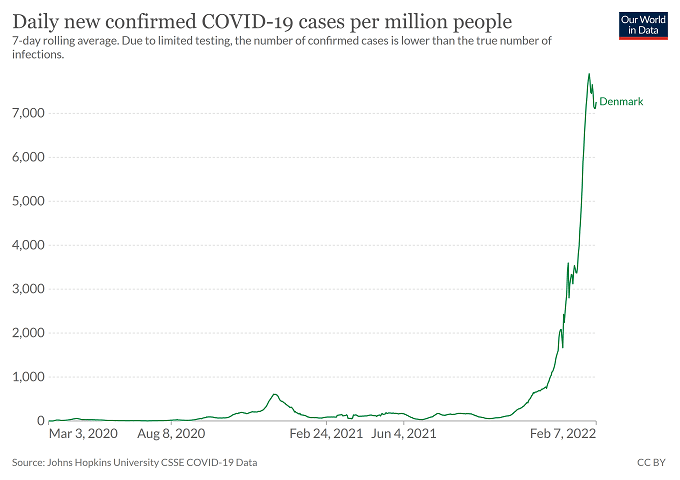
Denmark is currently the worst affected nation by the BA.2 sub-lineage, and very little is known about this variant’s severity compared to BA.1. It would be remiss NOT to keep an eye on the situation.
Figur 2 viser udviklingen i den covid-19 relaterede hospitalsbelægning per dag fordelt på i alt, psykiatri, intensiv og indlagte i respirator
Figure 2 above shows the development in the Covid-19 related hospital occupancy per day divided into total hospitalizations (red line), psychiatry (purple line), intensive care (blue line) and hospitalized on a respirator (green line).
Denmark: Over 90% of Covid infections are fully vaccinated *27 UPDATES*
We would like to thank the Danish SSI for its fantastic hard work and dedication in collating and publishing the vast amount of Covid-19 data that it does. We republish some of it here simply because Denmark has found itself at the leading edge of the latest Omicron/BA.1/BA.2 wave, and what happens in Denmark today will certainly happen in many other countries around the globe within the next few weeks.
